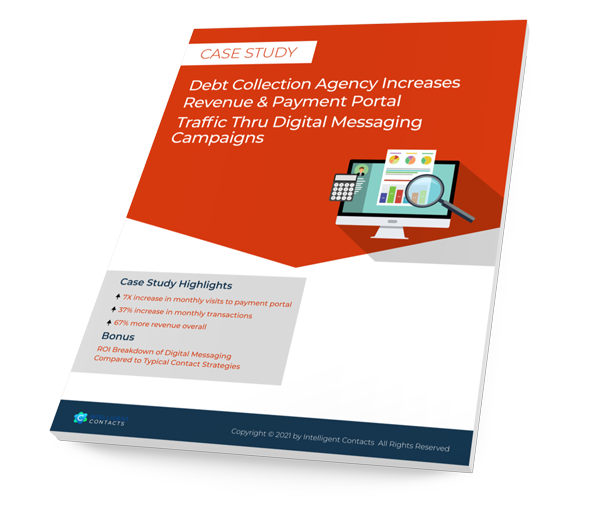PREDICTIVE DIALER | 10 MIN READ
What’s Driving the Shift to Digital Debt Collection

What’s driving the growing shift towards digital debt collection? There’s likely a number of contributing factors depending on who you ask and what specific business lines that agency serves. But for the companies who are aggressively making the transition to digital, the answer is results.
Or, more accurately, the lack of results seen through conventional outreach channels like phone calls and direct mail.
The first clue…the law of diminishing returns
The fact consumers have stopped answering their phone when they don’t recognize the number calling has been a long-known reality in the debt collection industry. However, the sheer percentage of such calls are forcing many agencies to engage through other channels.
Direct mail, although still a crucial communication channel for debt-related notifications, is also getting lower response rates than historically seen.
Enter digital channels like email, SMS, chat, voicemail drops, and even social media
With more tightly-defined compliance rules (thanks to Reg F) and clear evidence consumers prefer it, these new digital channels have become low-cost, effective methods for making right party contacts, sharing information, and collecting debt faster.
Welcome insight from some of the early adopters
So what’s this does the transition from a conventional debt collection agency to a digital one look like? And for those well into the transition, what are the results?
For Justin Franklin of Cedar Financial, pivoting to a digital-first collection strategy has confirmed what he had long suspected—that consumers who won’t answer their phone aren’t necessarily running away.
“That’s always been the thought in our industry for the last 5-10 years,” said Franklin in a recent webinar on the effectiveness of digital collections. “We’ve assumed they don’t want to talk to us. So we stay persistent, keep calling, and hope they’ll eventually get fed up and answer the call. But that’s not really the case.” said Franklin.
As Franklin went on to explain, many times consumers never open their collection letter because it arrives in an unmarked envelope and might look like junk mail. Then, with so many telemarketers bombarding their phone, they’ve simply adopted a habit of not answering calls from unfamiliar numbers.
Featured Topics
ARM Industry Topics
Healthcare Industry Topics
Contact Center Solutions & Topics
Auto & Predictive Dialing
Stealth Voicemail
Payment Topics & Solutions
Compliance & Data Security
CASE STUDY: DIGITAL MESSAGING CAMPAIGNS
A leading third-party accounts receivables company was searching for a more profitable way to engage consumers with special discounts and settlement offers.

Digital channels have much higher engagement rates
In comparison, email and SMS have much higher engagement rates, which then leads to a shorter window of time to resolve those accounts. Then, there’s the cost reduction aspect.
“With email and SMS, we’re not spending the same money to get the engagement that took 30, 60, 90 days, a second and third letter, then 20 calls,” said Franklin.
The increase in the volume and frequency in email and SMS messaging then leads to a natural uptick in online payments as digital connections often lead to digital collections. Convenience, as many agencies are discovering, is a powerful driver of consumer behavior.
Digital collections creates a path of least resistance where a consumer can self-manage and resolve their debt from their cell phone in just a few clicks.
To summarize, the shift from conventional to digital debt collection is the ARM industry’s adaptation to sudden and significant changes in how consumers interact with businesses. It’s both a response to the growing aversion people have towards receiving phone calls from strangers and the need and desire to manage things themselves on their own schedule.

Digital collections creates a path of least resistance where a consumer can self-manage and resolve their debt from their cell phone in just a few clicks.
Are consumers avoiding the message or the medium?
Paul Sachtelben, president of Frost-Arnett, provided some well-needed context on what the shift from conventional collection methods to a digital-focused model looks like practically.
Before deploying digital engagement channels like email, SMS, and webchat, Sachtelben had assumed like many that sinking response rates to phone calls and mailed letters meant consumers were becoming more reluctant to discuss or resolve their accounts.
“That’s always been the thought in our industry for the last 5-10 years,” said Franklin in a recent webinar on the effectiveness of digital collections. “We’ve assumed they don’t want to talk to us. So we stay persistent, keep calling, and hope they’ll eventually get fed up and answer the call. But that’s not really the case,” said Franklin.
As they began engaging consumers through all of these digital channels, they realized many consumers wanted to resolve their debt. They were resisting the communication method and not necessarily the message.
As Franklin went on to explain, many times a consumer never opens a collection letter because it arrives in an unmarked envelope and might look like junk mail. Similarly, with so many telemarketers bombarding their phone, they’ve simply adopted a habit of not answering calls from unfamiliar numbers.
Many times consumers never open their collection letter because it arrives in an unmarked envelope and might look like junk mail.”
Then, with so many telemarketers bombarding their phone, they’ve simply adopted a habit of not answering calls from unfamiliar numbers.”
Justin Franklin, Cedar Financial
%
Of Text Messages Are Read Within 5 Minutes of Receiving
Our Average Email Statistics
%
Deliverability Rate
%
Open Rate
%
Click-Through Rate
%
Portal Conversion / Close Rate
Want to know more?
Whether you’re looking to upgrade one part of your communication or payment process or the whole enchilada, we can help!
CASE STUDY








